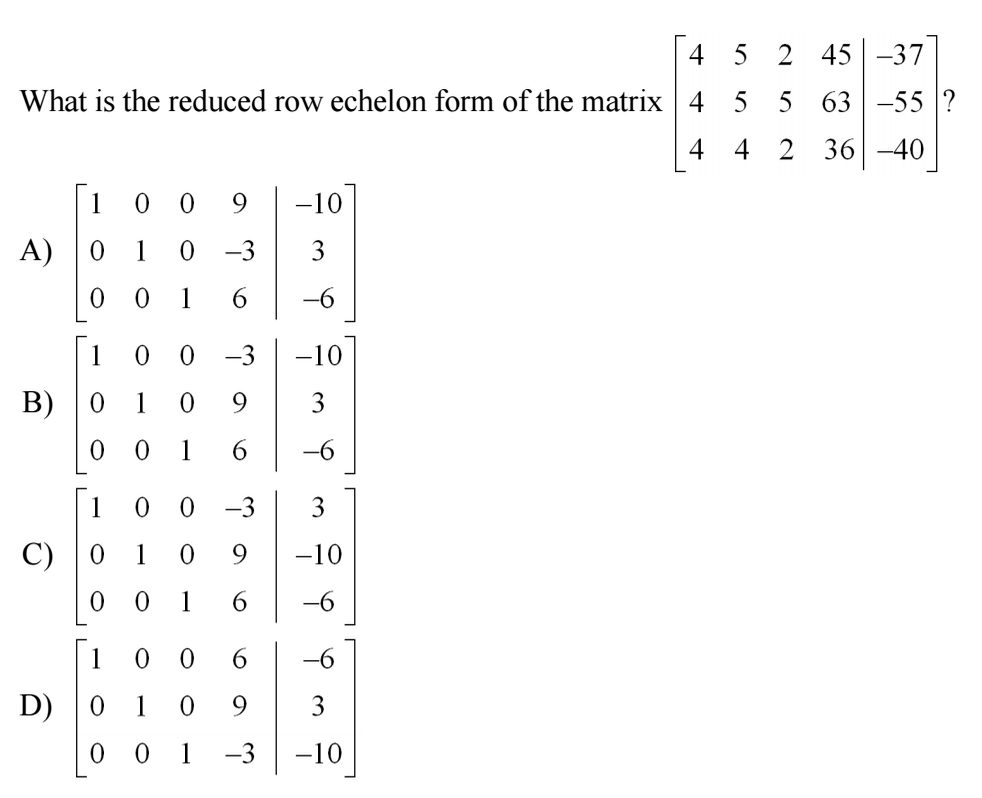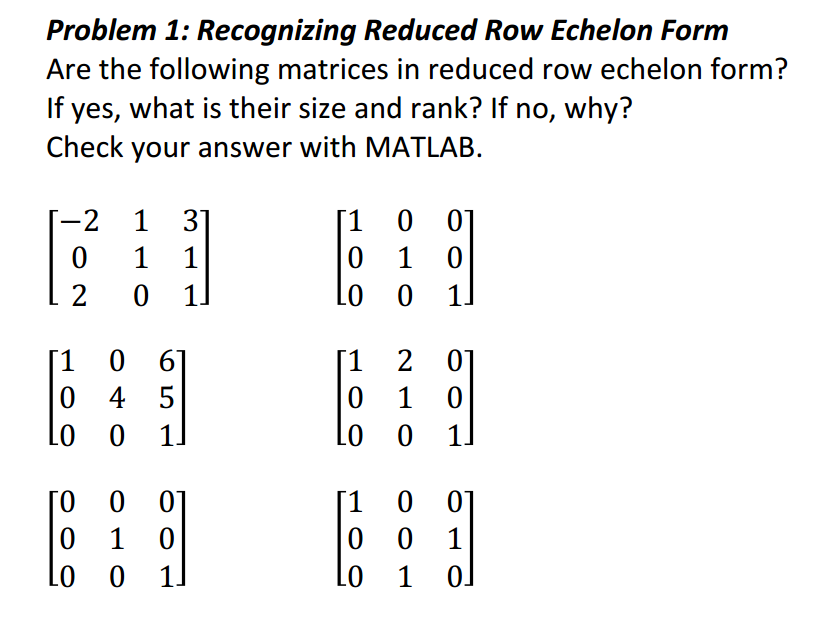Row Echelon Form Examples
Row Echelon Form Examples - Matrix b has a 1 in the 2nd position on the third row. Each leading 1 comes in a column to the right of the leading 1s in rows above it. 3.all entries in a column below a leading entry are zeros. Web example the matrix is in row echelon form because both of its rows have a pivot. Web the following examples are of matrices in echelon form: Web a matrix is in echelon form if: All rows of all 0s come at the bottom of the matrix. Example 1 label whether the matrix provided is in echelon form or reduced echelon form: Web echelon form, sometimes called gaussian elimination or ref, is a transformation of the augmented matrix to a point where we can use backward substitution to find the remaining values for our solution, as we say in our example above. All rows with only 0s are on the bottom.
All rows with only 0s are on the bottom. Example the matrix is in reduced row echelon form. 0 b b @ 0 1 1 7 1 0 0 3 15 3 0 0 0 0 2 0 0 0 0 0 1 c c a a matrix is in reduced echelon form if, additionally: A rectangular matrix is in echelon form (or row echelon form) if it has the following three properties: Web let us work through a few row echelon form examples so you can actively look for the differences between these two types of matrices. In any nonzero row, the rst nonzero entry is a one (called the leading one). 1.all nonzero rows are above any rows of all zeros. Web example the matrix is in row echelon form because both of its rows have a pivot. We can illustrate this by solving again our first example. Web echelon form, sometimes called gaussian elimination or ref, is a transformation of the augmented matrix to a point where we can use backward substitution to find the remaining values for our solution, as we say in our example above.
We can't 0 achieve this from matrix a unless interchange the ̄rst row with a row having a nonzero number in the ̄rst place. All zero rows are at the bottom of the matrix 2. In any nonzero row, the rst nonzero entry is a one (called the leading one). The first nonzero entry in each row is a 1 (called a leading 1). All zero rows (if any) belong at the bottom of the matrix. Web the matrix satisfies conditions for a row echelon form. We can illustrate this by solving again our first example. Web let us work through a few row echelon form examples so you can actively look for the differences between these two types of matrices. Each leading 1 comes in a column to the right of the leading 1s in rows above it. For example, (1 2 3 6 0 1 2 4 0 0 10 30) becomes → {x + 2y + 3z = 6 y + 2z = 4 10z = 30.
PPT ROWECHELON FORM AND REDUCED ROWECHELON FORM PowerPoint
For row echelon form, it needs to be to the right of the leading coefficient above it. Web the matrix satisfies conditions for a row echelon form. We immediately see that z = 3, which implies y = 4 − 2 ⋅ 3 = − 2 and x = 6 − 2( − 2) − 3 ⋅ 3 = 1..
Linear Algebra Example Problems Reduced Row Echelon Form YouTube
Each leading 1 comes in a column to the right of the leading 1s in rows above it. Each of the matrices shown below are examples of matrices in reduced row echelon form. Nonzero rows appear above the zero rows. Matrix b has a 1 in the 2nd position on the third row. We immediately see that z = 3,.
linear algebra Understanding the definition of row echelon form from
Web let us work through a few row echelon form examples so you can actively look for the differences between these two types of matrices. Web instead of gaussian elimination and back substitution, a system of equations can be solved by bringing a matrix to reduced row echelon form. Only 0s appear below the leading entry of each row. Using.
7.3.4 Reduced Row Echelon Form YouTube
A matrix is in reduced row echelon form if its entries satisfy the following conditions. 1.all nonzero rows are above any rows of all zeros. Web row echelon form is any matrix with the following properties: Beginning with the same augmented matrix, we have Using elementary row transformations, produce a row echelon form a0 of the matrix 2 3 0.
Elementary Linear Algebra Echelon Form of a Matrix, Part 1 YouTube
Web the following is an example of a 4x5 matrix in row echelon form, which is not in reduced row echelon form (see below): Web a rectangular matrix is in echelon form if it has the following three properties: A rectangular matrix is in echelon form (or row echelon form) if it has the following three properties: Web mathworld contributors.
Solve a system of using row echelon form an example YouTube
Each of the matrices shown below are examples of matrices in reduced row echelon form. Web the following examples are of matrices in echelon form: To solve this system, the matrix has to be reduced into reduced echelon form. Web instead of gaussian elimination and back substitution, a system of equations can be solved by bringing a matrix to reduced.
Solved What is the reduced row echelon form of the matrix
Web the following examples are of matrices in echelon form: The first nonzero entry in each row is a 1 (called a leading 1). All zero rows are at the bottom of the matrix 2. ¡3 4 ¡2 ¡5 2 3 we know that the ̄rst nonzero column of a0 must be of view 4 0 5. Web existence and.
Solved Are The Following Matrices In Reduced Row Echelon
Nonzero rows appear above the zero rows. Web row echelon form is any matrix with the following properties: The first nonzero entry in each row is a 1 (called a leading 1). Each of the matrices shown below are examples of matrices in reduced row echelon form. In any nonzero row, the rst nonzero entry is a one (called the.
Uniqueness of Reduced Row Echelon Form YouTube
Using elementary row transformations, produce a row echelon form a0 of the matrix 2 3 0 2 8 ¡7 = 4 2 ¡2 4 0 5 : Each leading 1 comes in a column to the right of the leading 1s in rows above it. ¡3 4 ¡2 ¡5 2 3 we know that the ̄rst nonzero column of a0.
Row Echelon Form of a Matrix YouTube
For row echelon form, it needs to be to the right of the leading coefficient above it. We can illustrate this by solving again our first example. All zero rows are at the bottom of the matrix 2. Web a matrix is in echelon form if: 1.all nonzero rows are above any rows of all zeros.
Web A Rectangular Matrix Is In Echelon Form If It Has The Following Three Properties:
Example the matrix is in reduced row echelon form. A matrix is in reduced row echelon form if its entries satisfy the following conditions. The following matrices are in echelon form (ref). A rectangular matrix is in echelon form (or row echelon form) if it has the following three properties:
The Leading Entry ( Rst Nonzero Entry) Of Each Row Is To The Right Of The Leading Entry.
For example, (1 2 3 6 0 1 2 4 0 0 10 30) becomes → {x + 2y + 3z = 6 y + 2z = 4 10z = 30. Nonzero rows appear above the zero rows. All zero rows are at the bottom of the matrix 2. 1.all nonzero rows are above any rows of all zeros.
We Can't 0 Achieve This From Matrix A Unless Interchange The ̄Rst Row With A Row Having A Nonzero Number In The ̄Rst Place.
Web mathworld contributors derwent more. All rows with only 0s are on the bottom. Web example the matrix is in row echelon form because both of its rows have a pivot. Web for example, given the following linear system with corresponding augmented matrix:
All Nonzero Rows Are Above Any Rows Of All Zeros 2.
To solve this system, the matrix has to be reduced into reduced echelon form. We can illustrate this by solving again our first example. We immediately see that z = 3, which implies y = 4 − 2 ⋅ 3 = − 2 and x = 6 − 2( − 2) − 3 ⋅ 3 = 1. The following examples are not in echelon form:









